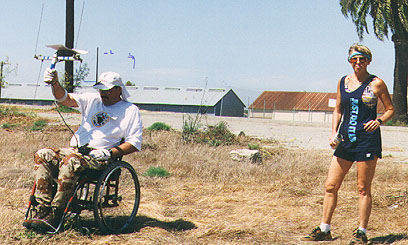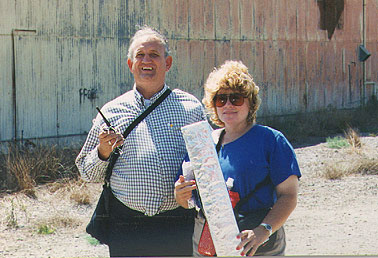Extenders Aid Handicapped Foxhunters
The following story from a
southern California ARDF event was originally featured in Homing In for January
1996. It shows that age and disabilities need not be a barrier to foxhunting
fun.
UPDATE: Mike Obermeier, who became K6SNE in 1999, perished when his T-hunt equipped Jeep Cherokee went off a mountain road in May 2006.
Joe Moell KØOV
Everyone Is Able
Foxhunters who win international championships are true athletes who train just
like world-class competitors in any other running sport. By contrast,
Hamcon/Foxhunt-95 entrants were a cross-section of ordinary hams, ranging in
age from 11 to 70. The median age was 38. There were no
cross-country runners, and two could not run at all. The story of these two is
proof that foxhunting is a sport for almost everyone.
Mike Obermeier KD6SNE is a regular at southern California mobile T-hunts.
Because of a spinal cord injury, Mike has adapted his T-hunt vehicle to include
hand controls for the accelerator and brakes. In just a few seconds,
he can maneuver himself out of the truck and into his sports wheelchair for
sniffing out the T.

Mike Obermeier KD6SNE "sniffs" in his wheelchair and T-hunts
regularly on two meters. At the time this article was written, his main T-hunting vehicle was a converted mail delivery truck with a 4-element
quad and a Roanoke Doppler. The photo isn't backwards; the steering wheel
really is on the right side.
When I promoted this foxhunt at a mobile T-hunt in August, Mike told me he
really wanted to compete. He kept asking, "Can I do it in my chair?" I knew
the site had plenty of paved and unpaved trails, but there would be no way to
place all the foxes so he could roll right to them. There are no provisions in
the IARU foxhunt rules for this sort of situation. Mike didn't want a special
course just for him, nor did he want the course made easier on his account.
All he needed was a way to finish closing in after he had done the basic RDF
work on wheels.
Fortunately, I had an expert nearby for consultation. My wife April WA6OPS is
a Registered Occupational Therapist and former rehabilitation department head
at a major medical center in Orange County. Occupational Therapists are
trained to find creative ways for persons with disabilities to adapt to their
physical limitations and return to regular activities of their daily living.
April suggested that Mike be provided with an assistant on the foxhunt course
to perform search duties in areas of the park that were inaccessible to his
wheelchair. I countered that the competition was for individuals only, not
two-person teams, and that other contestants might consider it unfair to go up
against the team of Mike and an assistant. After some discussion, we agreed
that the assistant would be selected by the hunt committee and would be allowed
to act only as an extension of Mike's range. Mike would do all the RDF work
and maneuver his chair as close as possible to the foxes. Then Mike's Extender
would go into any inaccessible places and search, without equipment, at his
direction.
Mike thought this idea was great and quickly agreed to the terms and
conditions. Christie Edinger KØIU agreed to act as his Extender. There was no
concern about Christie being able to keep up with Mike, because she is an
accomplished marathon runner.

KD6SNE cruised the Hamcon/Foxhunt-95 course in his wheelchair. Christie
Edinger KØIU, his Extender, went into the brush on his command to uncover
foxes and punch his competitor card.
One week before Hamcon/Foxhunt-95, I received e-mail from Marvin Johnston
KE6HTS of Santa Barbara. He and Dennis Schwendtner WB6OBB were coming to the
hunt and he wanted to know if Dennis could participate on a team. I already
knew that WB6OBB's keen hearing had made him a successful "navigator" on mobile
T-hunts in Santa Barbara for many years, despite the fact that he is sightless.
I told Marvin that there would not be a team competition, but we would try to
find another good Extender so that Dennis could hunt.
WB6OBB liked the idea, so April asked an acquaintance who had expressed
interest in Amateur Radio to be his Extender. April's instructions were that
she could act only as eyes for Dennis, and could not do any RDF for him.
Besides insuring his safety, she was allowed to describe to Dennis the terrain
features and the presence of other hunters in the area in which they were
searching.

Long-time T-hunter Dennis Schwendtner WB6OBB didn't let his blindness
keep him from having fun at Hamcon/Foxhunt-95. Linda Reagan (now KF6MOB) served
as his Extender.
No one at the foxhunt starting line was more excited than Mike and Dennis. Of
course, not all sporting events turn out like a Rocky or Mighty Ducks movie.
Neither Mike nor Dennis won a medal. However, both received certificates for
successfully finding foxes, and their extenders got a real workout. I'm sure
all four are hoping that organizers here and abroad will improve the rules so
all future international-rules foxhunts are as accessible to handicapped hams
as this one was.

On the downhill, KØIU had to move fast to keep up with KD6SNE.
Text and photos Copyright ©1996 Joseph D. Moell. All rights reserved.
 Go to International-Style Foxhunting Comes To The Americas -- How we're getting the ball rolling
Go to International-Style Foxhunting Comes To The Americas -- How we're getting the ball rolling
Go to Latest Championship Foxhunting News -- Stories of recent national/international ARDF events and announcements of upcoming ones
Go to Equipment Ideas for Radio-Orienteering -- Simple and inexpensive receiving and transmitting solutions
Go to Foxhunting for Scouts -- Let's get the kids involved
Go to Electronic Scoring for ARDF -- What it is, how it works, and why it's better than pin punching
Back to the Homing In home page
This page updated 7 April 2008




